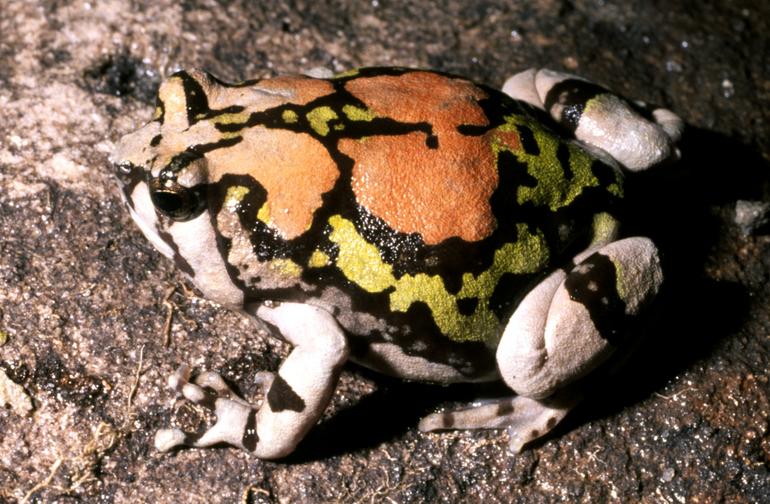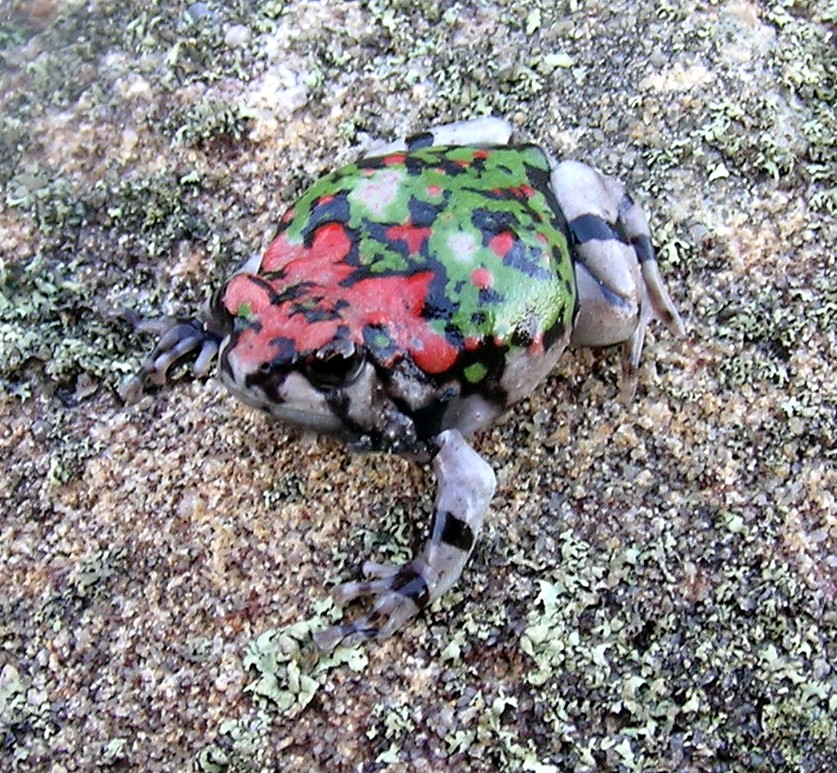This frog species is often found on lists of bizarre species of the herpetofauna from around the world. From well-known biodiversity hotspot Madagascar, this colourful species is a joy to behold.
This frog species is often found on lists of bizarre species of the herpetofauna from around the world. From well-known biodiversity hotspot Madagascar, this colourful species is a joy to behold.

By Franco Andreone – see authorization – http://calphotos.berkeley.edu, CC BY-SA 2.5, https://commons.wikimedia.org/w/index.php?curid=3963091
By Franco Andreone – see authorization – http://calphotos.berkeley.edu, CC BY-SA 2.5, https://commons.wikimedia.org/w/index.php?curid=3963091
S. gottlebei goes by the names Malagasy rainbow frog, ornate hopper, rainbow burrowing frog, red rain frog, or Gottlebe’s narrow mouthed frog (hence gottlebei). Madagascar is home to many wonderful frog species, but this is by far one of the most flashy and decorated.
This frog is found at 700-1000m altitudes in Madagascar, in narrow, cool canyon habitats. Preferring cooler temperatures and high humidity, S. gottlebei burrows into sand alongside streams or gets comfortable within rock crevices. It’s a good climber as well as digger, venturing high up during its nocturnal wanderings.
This species is described as an ‘explosive breeder’. They are also short lived as adults – reaching 2 years of age on average. That means breeding season needs to count!
During November-December, cued by heavy rainfall, eggs will be laid in the temporary rain pools and will hatch within 3 days.
Tadpoles have a strange habit of spending prolonged amounts of time with their head submerged in sediment to feed on detritus.
As is the case for many Malagasy herpetofauna, this frog is categorised as an endangered species under IUCN. This is down to its somewhat restricted range and the fact that habitats in Madagascar are generally shrinking due to agricultural advancements and wood extraction processes.
Unfortunately, thousands have also been detected as collected for the pet trade. This is also a massive threat, and brings to light the need for responsible exotics sourcing and responsible purchasing by hobbyists.
Its CITES Appendix II collection quota was reduced to 0 in 2014 – which means export is now illegal for this species. So please, enjoy captive bred individuals or see them in situ!
S. gottlebei goes by the names Malagasy rainbow frog, ornate hopper, rainbow burrowing frog, red rain frog, or Gottlebe’s narrow mouthed frog (hence gottlebei). Madagascar is home to many wonderful frog species, but this is by far one of the most flashy and decorated.
This frog is found at 700-1000m altitudes in Madagascar, in narrow, cool canyon habitats. Preferring cooler temperatures and high humidity, S. gottlebei burrows into sand alongside streams or gets comfortable within rock crevices. It’s a good climber as well as digger, venturing high up during its nocturnal wanderings.
This species is described as an ‘explosive breeder’. They are also short lived as adults – reaching 2 years of age on average. That means breeding season needs to count!
During November-December, cued by heavy rainfall, eggs will be laid in the temporary rain pools and will hatch within 3 days.
Tadpoles have a strange habit of spending prolonged amounts of time with their head submerged in sediment to feed on detritus.
As is the case for many Malagasy herpetofauna, this frog is categorised as an endangered species under IUCN. This is down to its somewhat restricted range and the fact that habitats in Madagascar are generally shrinking due to agricultural advancements and wood extraction processes.
Unfortunately, thousands have also been detected as collected for the pet trade. This is also a massive threat, and brings to light the need for responsible exotics sourcing and responsible purchasing by hobbyists.
Its CITES Appendix II collection quota was reduced to 0 in 2014 – which means export is now illegal for this species. So please, enjoy captive bred individuals or see them in situ!
